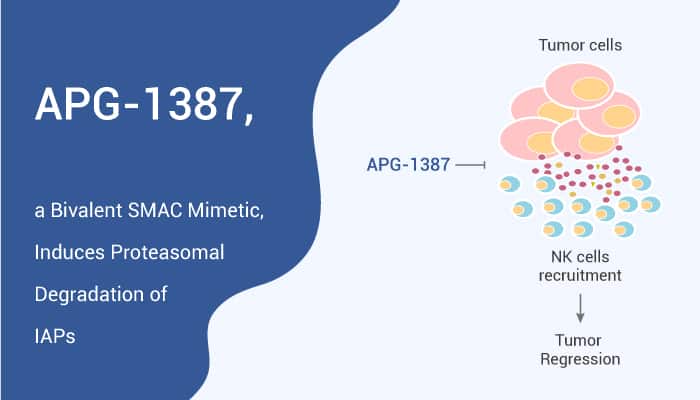Apoptosis protein inhibitors (IAP) are a class of functional and structural proteins, which are endogenous inhibitors of apoptosis.
Specifically, inappropriate mutation or regulation will usually lead to cancer or other effects on cells. They include the Bcl-2 family, viral inhibitor crmA, and IAP’s. Besides, the most characteristic of IAAP is XIAP, which can bind caspase-9, caspase-3, and caspase-7 to inhibit their activation and prevent apoptosis. Moreover, IAP inhibitors include cell IAP1 (cIAP1), cell IAP2 (cIAP2), and X-linked apoptosis protein inhibitor (XIAP). They block the cascade of caspase activation. Furthermore, XIAP directly binds and inhibits Caspase-3, -7, and -9. cIAP1 and cIAP2 prevent the formation of the cell death receptor complex and the activation of caspase-8. APG-1387 is a bivalent SMAC mimetic and an IAP antagonist.
APG-1387 is a bivalent SMAC mimetic and an IAP antagonist.

How does APG-1387 work on the target? At first, APG-1387 blocks the activity of IAPs family proteins. Meanwhile, APG-1387 induces degradation of cIAP-1 and XIAP proteins, as well as caspase-3 and PARP. Nonetheless, APG-1387 can be used for the research of hepatocellular carcinoma, ovarian cancer, and nasopharyngeal carcinoma.
In the second place, APG-1387 with 0.02-20 μM for 24 h decreased the expression of cIAP1 and cIAP2 in both cell lines in a dose- and time-dependent manner. Importantly, APG-1387 inhibits the XIAP expression at a high dose. Particularly, APG-1387 enhances TNF-α- and TRAIL-mediated anti-cancer activities in HCC cell lines. Obviously, APG-1387 sensitizes HepG2 and HCCLM3 cells to NK cell-mediated killing in vitro.
Last but not the least, APG-1387 with 20 mg/kg sensitizes HCCLM3 tumors toward NK cell-mediated killing in mice. In particular, APG-1387 decreases the expression of cIAP1, cIAP2, and XIAP.
All in all, APG-1387 is a bivalent SMAC mimetic and an IAP antagonist.
References:
Chen Z, et, al. Front Pharmacol. 2018 Nov 6; 9:1298.